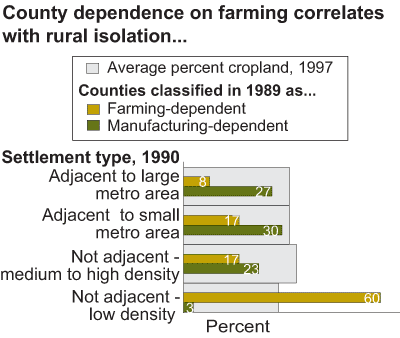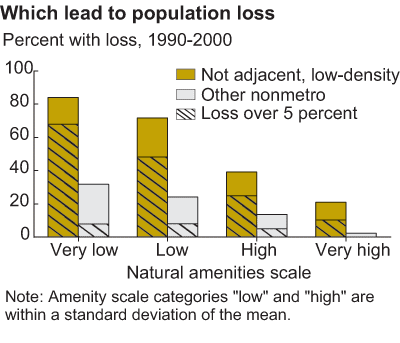The Roots of Rural Population Loss
- by David McGranahan and Calvin L. Beale
- 2/3/2003
One in four nonmetropolitan (nonmetro) counties lost population between 1990 and 2000. Many of these counties have been losing population for decades. Over half of 'farming-dependent' counties, where farming accounted for at least 20 percent of earnings in 1987-89, had fewer residents in 2000 than in 1990. The 565 farming-dependent counties represent about a quarter of all nonmetro, or rural, counties, but they comprise nearly two-thirds of the counties with population losses of over 5 percent in 1990-2000.
Declining farm employment is often cited as the reason that these counties have been losing population. But recent ERS research suggests that the drawback for such counties is less their agriculture than their remoteness and thin settlement, together with a lack of natural amenities. Natural amenities, including varied topography, lakes and ocean shore, sunny winters, and temperate summers, are a magnet for population and tourism.
Optimal conditions for most types of farming—flat and unbroken land, wet winters, and hot, humid summers—are not usually associated with the natural amenities that attract new residents. Thus, counties with low scores on the natural amenity scale tend to have extensive cropland but little recreation and second home development.
Young adults tend to move away from thinly settled, remote rural counties. Without natural amenities, these counties did not attract enough young families and retirees in the 1990s to make up for the loss of young adults. Over 80 percent lost population in 1990-2000. In contrast, only a small proportion of counties with very high amenity scores lost population.
Some poorly situated counties did gain population in the 1990s, often thanks to industrial agriculture, new Native American casinos, recreation and retirement around lakes, and new prisons.
This article is drawn from:
- Hamrick, K. (2002). Rural America at a Glance. U.S. Department of Agriculture, Economic Research Service. RDRR-94-1.
- Understanding Rural Population Loss. (2002). USDA/ERS. Rural America, Vol. 17, No. 4, Winter..




